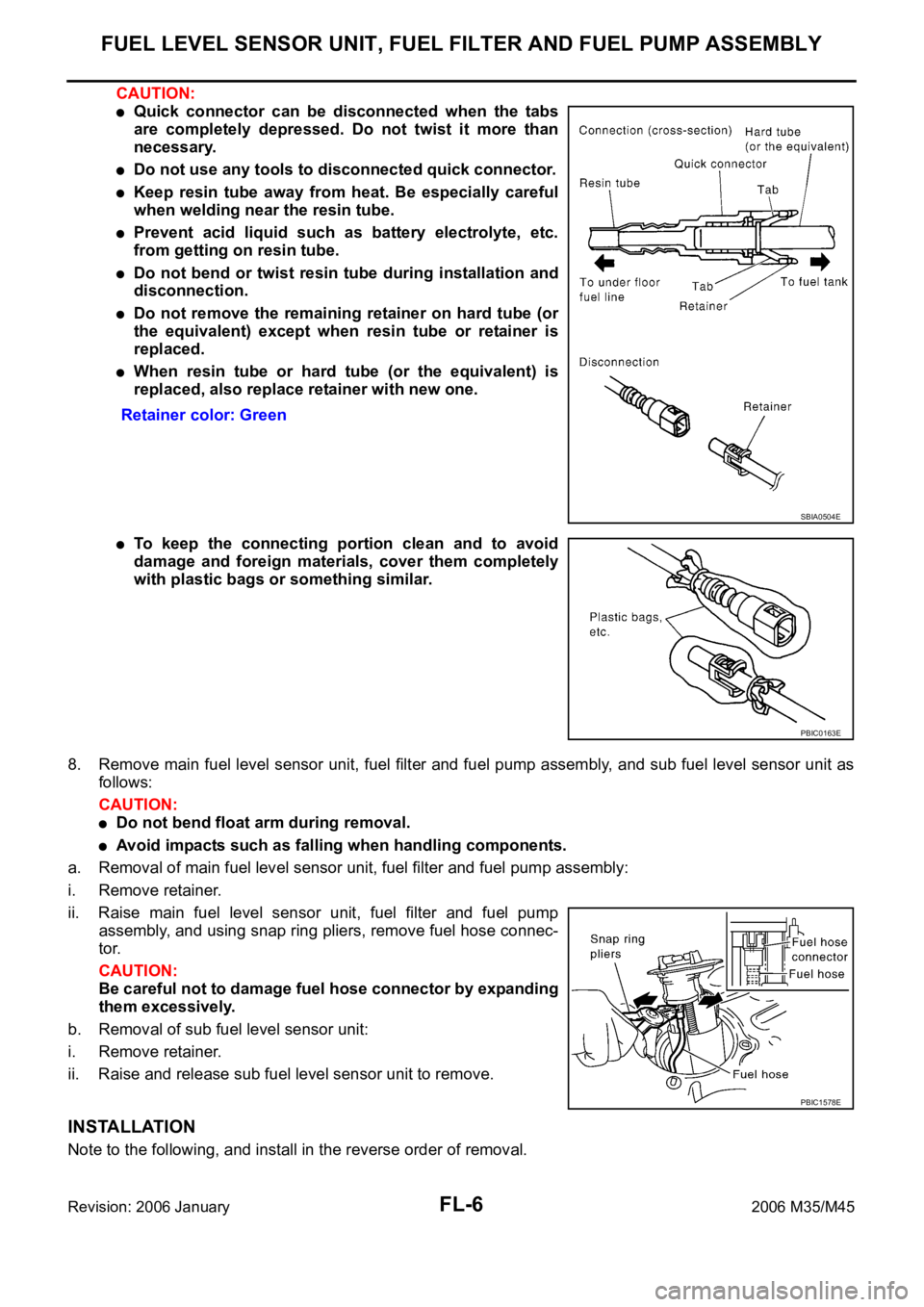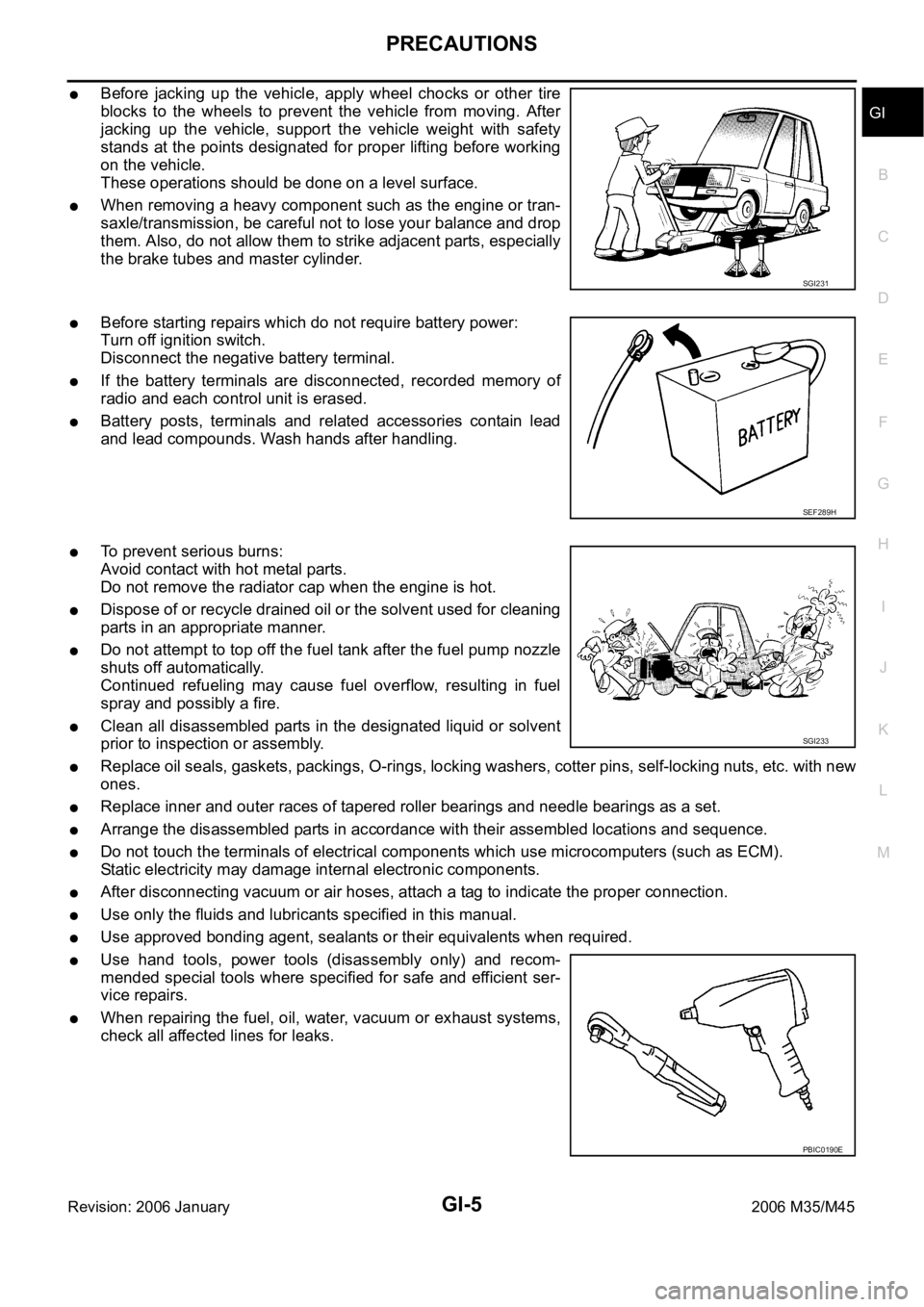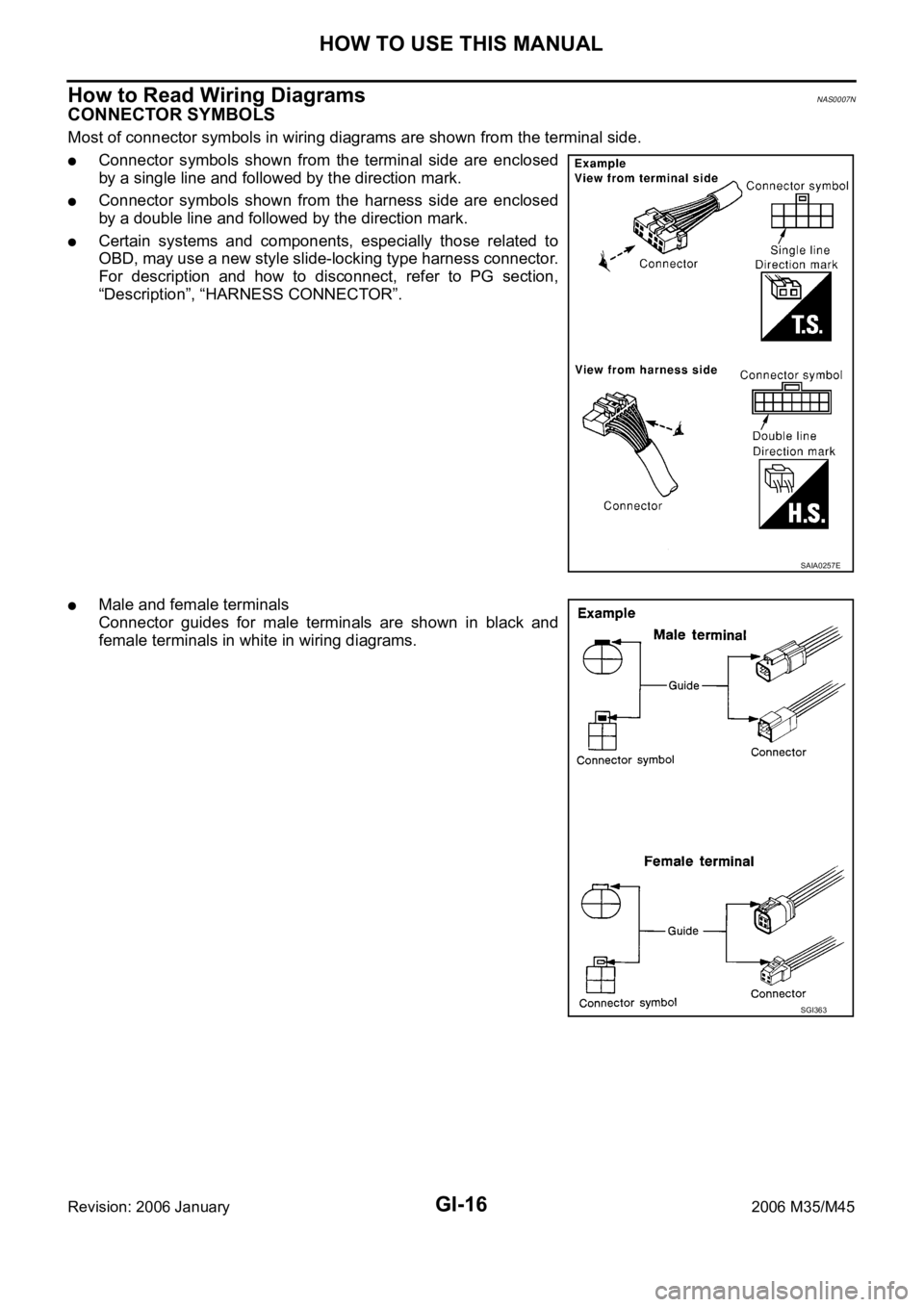2006 INFINITI M35 ESP
[x] Cancel search: ESPPage 3297 of 5621
![INFINITI M35 2006 Factory Service Manual EM-234
[VK45DE]
CYLINDER HEAD
Revision: 2006 January2006 M35/M45
If the engine speed is out of specified range, check battery liquid for proper gravity. Check engine
speed again with normal INFINITI M35 2006 Factory Service Manual EM-234
[VK45DE]
CYLINDER HEAD
Revision: 2006 January2006 M35/M45
If the engine speed is out of specified range, check battery liquid for proper gravity. Check engine
speed again with normal](/manual-img/42/57023/w960_57023-3296.png)
EM-234
[VK45DE]
CYLINDER HEAD
Revision: 2006 January2006 M35/M45
If the engine speed is out of specified range, check battery liquid for proper gravity. Check engine
speed again with normal battery gravity.
If compression pressure is below minimum value, check valve clearances and parts associated with
combustion chamber (valve, valve seat, piston, piston ring, cylinder bore, cylinder head, cylinder head
gasket). After the checking, measure compression pressure again.
If some cylinders have low compression pressure, pour small amount of engine oil into the spark plug
hole of the cylinder to re-check it for compression.
–If the added engine oil improves the compression, piston rings may be worn out or damaged. Check the
piston rings and replace if necessary.
–If the compression pressure remains at low level despite the addition of engine oil, valves may be mal-
functioning. Check valves for damage. Replace valve or valve seat accordingly.
If two adjacent cylinders have respectively low compression pressure and their compression remains
low even after the addition of engine oil, cylinder head gaskets are leaking. In such a case, replace cyl-
inder head gaskets.
8. After inspection is completed, install removed parts in the reverse order of removal.
9. Start engine, and make sure that engine runs smoothly.
10. Perform trouble diagnosis. If DTC appears, erase it. Refer to EC-811, "
TROUBLE DIAGNOSIS" .
ComponentsNBS004PG
Removal and InstallationNBS004PH
REMOVAL
1. Remove engine assembly from vehicle. Refer to EM-244, "ENGINE ASSEMBLY" .
2. Remove exhaust manifold. Refer to EM-183, "
EXHAUST MANIFOLD AND THREE WAY CATALYST" .
3. Remove camshaft. Refer to EM-215, "
CAMSHAFT" .
1. Engine coolant temperature sensor 2. Washer 3. Cylinder head gasket (left bank)
4. Harness bracket 5. Cylinder head (right bank) 6. Cylinder head bolt
7. Cylinder head gasket (right bank) 8. Cylinder head bolt 9. Cylinder head (left bank)
PBIC2756E
Page 3314 of 5621
![INFINITI M35 2006 Factory Service Manual CYLINDER BLOCK
EM-251
[VK45DE]
C
D
E
F
G
H
I
J
K
L
MA
EM
Revision: 2006 January2006 M35/M45
–Fuel tube and fuel injector assembly; Refer to EM-193, "FUEL INJECTOR AND FUEL TUBE" .
–Ignitio INFINITI M35 2006 Factory Service Manual CYLINDER BLOCK
EM-251
[VK45DE]
C
D
E
F
G
H
I
J
K
L
MA
EM
Revision: 2006 January2006 M35/M45
–Fuel tube and fuel injector assembly; Refer to EM-193, "FUEL INJECTOR AND FUEL TUBE" .
–Ignitio](/manual-img/42/57023/w960_57023-3313.png)
CYLINDER BLOCK
EM-251
[VK45DE]
C
D
E
F
G
H
I
J
K
L
MA
EM
Revision: 2006 January2006 M35/M45
–Fuel tube and fuel injector assembly; Refer to EM-193, "FUEL INJECTOR AND FUEL TUBE" .
–Ignition coil; Refer to EM-190, "IGNITION COIL" .
–Rocker cover; Refer to EM-199, "ROCKER COVER" .
–Other removable brackets
NOTE:
The figure shows an example of widely use engine stand that
can hold mating surface of transmission with drive plate and rear
plate removed.
CAUTION:
Before removing the hanging chains, make sure the engine
stand is stable and there is no risk of overturning.
4. Drain engine oil. Refer to LU-28, "
Changing Engine Oil" .
5. Drain engine coolant from inside engine by removing water
drain plugs “B” as shown in the figure.
6. Remove oil pan and oil strainer; Refer to EM-187, "
OIL PAN AND OIL STRAINER" .
7. Remove crankshaft pulley as follows:
a. Lock crankshaft with a hammer handle or similar tool to loosen
crankshaft bolt.
b. Pull crankshaft pulley with both hands to remove it.
CAUTION:
Do not remove crankshaft pulley bolt. Keep loosened
crankshaft pulley bolt in place to protect removed crank-
shaft pulley from dropping.
Do not remove balance weight (inner hexagon bolt) at the
front of crankshaft pulley.
8. Remove the following parts and related parts (The parts listed in step 3 are not included here.)
Front cover and timing chain; Refer to EM-203, "TIMING CHAIN" .
Camshaft; Refer to EM-215, "CAMSHAFT" .
Cylinder head; Refer to EM-233, "CYLINDER HEAD" .
9. Remove knock sensor.
CAUTION:
Carefully handle sensor, avoiding shocks.
10. Remove piston and connecting rod assembly as follows:
Before removing piston and connecting rod assembly, check the connecting rod side clearance. Refer
to EM-266, "
CONNECTING ROD SIDE CLEARANCE" .
a. Position crankshaft pin corresponding to connecting rod to be removed onto the bottom dead center.
b. Remove connecting rod bearing cap.
PBIC0085E
PBIC1265E
PBIC0053E
Page 3321 of 5621
![INFINITI M35 2006 Factory Service Manual EM-258
[VK45DE]
CYLINDER BLOCK
Revision: 2006 January2006 M35/M45
When installing, align the connecting rod bearing stopper pro-
trusion with the cutout of connecting rod and connecting rod
b INFINITI M35 2006 Factory Service Manual EM-258
[VK45DE]
CYLINDER BLOCK
Revision: 2006 January2006 M35/M45
When installing, align the connecting rod bearing stopper pro-
trusion with the cutout of connecting rod and connecting rod
b](/manual-img/42/57023/w960_57023-3320.png)
EM-258
[VK45DE]
CYLINDER BLOCK
Revision: 2006 January2006 M35/M45
When installing, align the connecting rod bearing stopper pro-
trusion with the cutout of connecting rod and connecting rod
bearing cap to install.
Ensure the oil holes on connecting rod and that on the corre-
sponding bearing are aligned.
13. Install piston and connecting rod assembly to crankshaft.
Position the crankshaft pin corresponding to connecting rod to be installed onto the bottom dead center.
Apply engine oil sufficiently to the cylinder bore, piston and crankshaft pin journal.
Match the cylinder position with the cylinder No. on connecting rod to install.
Be sure that front mark on piston head is facing front of engine.
Using piston ring compressor [SST: EM03470000 (J8037)],
install piston with the front mark on the piston head facing the
front of engine.
CAUTION:
Be careful not to damage cylinder wall and crankshaft pin,
resulting from an interference of the connecting rod big
end.
14. Install connecting rod bearing cap.
Match the stamped cylinder number marks on connecting rod
with those on cap to install.
15. Tighten connecting rod nuts as follows:
a. Apply new engine oil to the threads and seats of connecting rod bolts and nuts.
b. Tighten connecting rod nuts.
c. Then tighten all connecting rod nuts 60 degrees clockwise.
(Angle tightening)
CAUTION:
Use angle wrench (SST) to check tightening angle. Do not
make judgment by visual inspection.
After tightening connecting rod nuts, make sure that crank-
shaft rotates smoothly.
Check the connecting rod side clearance. Refer to EM-266,
"CONNECTING ROD SIDE CLEARANCE" .
PBIC2370E
PBIC0102E
PBIC2164E
: 14.7 Nꞏm (1.5 kg-m, 11 ft-lb)
PBIC0104E
Page 3324 of 5621
![INFINITI M35 2006 Factory Service Manual CYLINDER BLOCK
EM-261
[VK45DE]
C
D
E
F
G
H
I
J
K
L
MA
EM
Revision: 2006 January2006 M35/M45
HOW TO SELECT CONNECTING ROD BEARING
When New Connecting Rod and Crankshaft are Used
Check pin diameter grad INFINITI M35 2006 Factory Service Manual CYLINDER BLOCK
EM-261
[VK45DE]
C
D
E
F
G
H
I
J
K
L
MA
EM
Revision: 2006 January2006 M35/M45
HOW TO SELECT CONNECTING ROD BEARING
When New Connecting Rod and Crankshaft are Used
Check pin diameter grad](/manual-img/42/57023/w960_57023-3323.png)
CYLINDER BLOCK
EM-261
[VK45DE]
C
D
E
F
G
H
I
J
K
L
MA
EM
Revision: 2006 January2006 M35/M45
HOW TO SELECT CONNECTING ROD BEARING
When New Connecting Rod and Crankshaft are Used
Check pin diameter grade (“0”, “1” or “2”) on front of crankshaft, and
select connecting rod bearing of the same grade.
NOTE:
There is no grading for connecting rod big end diameter.
When Crankshaft and Connecting Rod are Reused
1. Measure the connecting rod big end diameter. Refer to EM-268, "CONNECTING ROD BIG END DIAME-
TER" .
2. Make sure that the connecting rod big end diameter is within the standard value.
3. Measure the crankshaft pin journal diameter. Refer to EM-272, "
CRANKSHAFT PIN JOURNAL DIAME-
TER" .
4. Determine the grade of crankshaft pin diameter grade by corresponding to the measured dimension in
“Crankshaft pin journal diameter” column of “Connecting Rod Bearing Selection Table”.
5. Select connecting rod bearing of the same grade.
Connecting Rod Bearing Selection Table
Unit: mm (in)
Unit: mm (in)
Under Size Bearings Usage Guide
When the specified connecting rod bearing oil clearance is not obtained with standard size connecting rod
bearings, use undersize (US) bearings.
When using undersize (US) bearing, measure the connecting rod bearing inner diameter with bearing
installed, and grind crankshaft pin so that the connecting rod bearing oil clearance satisfies the standard.
CAUTION:
In grinding crankshaft pin to use undersize bearings, keep
the fillet R [1.5 mm (0.059 in)].
Bearing undersize table
Unit: mm (in)
PBIC2374E
Connecting rod big end diameter 55.000 - 55.013 (2.1654 - 2.1659)
Crankshaft Connecting rod bearing
Crankshaft pin journal diameter Grade (Mark) Dimension (Bearing thickness range) Bearing grade No. Color
51.968 - 51.974 (2.0460 - 2.0462) 0 1.500 - 1.503 (0.0591 - 0.0592) STD 0 No color
51.962 - 51.968 (2.0457 - 2.0460) 1 1.503 - 1.506 (0.0592 - 0.0593) STD 1 Brown
51.956 - 51.962 (2.0455 - 2.0457) 2 1.506 - 1.509 (0.0593 - 0.0594) STD 2 Green
PBIC2373E
Size Thickness
US 0.25 (0.0098) 1.626 - 1.634 (0.0640 - 0.0643)
Page 3325 of 5621
![INFINITI M35 2006 Factory Service Manual EM-262
[VK45DE]
CYLINDER BLOCK
Revision: 2006 January2006 M35/M45
HOW TO SELECT MAIN BEARING
When New Cylinder Block and Crankshaft are Used
1. “Main Bearing Selection Table” rows correspond to ma INFINITI M35 2006 Factory Service Manual EM-262
[VK45DE]
CYLINDER BLOCK
Revision: 2006 January2006 M35/M45
HOW TO SELECT MAIN BEARING
When New Cylinder Block and Crankshaft are Used
1. “Main Bearing Selection Table” rows correspond to ma](/manual-img/42/57023/w960_57023-3324.png)
EM-262
[VK45DE]
CYLINDER BLOCK
Revision: 2006 January2006 M35/M45
HOW TO SELECT MAIN BEARING
When New Cylinder Block and Crankshaft are Used
1. “Main Bearing Selection Table” rows correspond to main bearing
housing grade on rear upper side between cylinder block banks.
2. “Main Bearing Selection Table” columns correspond to main
journal diameter grade on front side of crankshaft.
3. Select main bearing grade at the point where selected row and column meat in “Main Bearing Selection
Table”.
CAUTION:
Initial clearance for No. 1, 5 journal and No. 2, 3, 4 journal is different. Use two different selection
table for each part.
No. 1, 5 journal and No. 2, 3, 4 journal have the same signs but different measures. Do not con-
fuse.
4. Apply sign at crossing in above step 3 to “Main Bearing Grade Table”.
NOTE:
“Main Bearing Grade Table” applies to all journals.
Service parts is available as a set of both upper and lower.
When Cylinder Block and Crankshaft are Reused
1. Measure the cylinder block main bearing housing inner diameter and the crankshaft main journal diame-
ter. Refer to EM-270, "
MAIN BEARING HOUSING INNER DIAMETER" and EM-271, "CRANKSHAFT
MAIN JOURNAL DIAMETER" .
2. Correspond the measured dimension in “Cylinder block main bearing housing inner diameter” row of
“Main Bearing Selection Table”.
3. Correspond the measured dimension in “Crankshaft main journal diameter” column of “Main Bearing
Selection Table”.
4. Follow step 3 and later in “When New Cylinder Block and Crankshaft are Used”.
PBIC2371E
PBIC2374E
Page 3419 of 5621

FL-6
FUEL LEVEL SENSOR UNIT, FUEL FILTER AND FUEL PUMP ASSEMBLY
Revision: 2006 January2006 M35/M45
CAUTION:
Quick connector can be disconnected when the tabs
are completely depressed. Do not twist it more than
necessary.
Do not use any tools to disconnected quick connector.
Keep resin tube away from heat. Be especially careful
when welding near the resin tube.
Prevent acid liquid such as battery electrolyte, etc.
from getting on resin tube.
Do not bend or twist resin tube during installation and
disconnection.
Do not remove the remaining retainer on hard tube (or
the equivalent) except when resin tube or retainer is
replaced.
When resin tube or hard tube (or the equivalent) is
replaced, also replace retainer with new one.
To keep the connecting portion clean and to avoid
damage and foreign materials, cover them completely
with plastic bags or something similar.
8. Remove main fuel level sensor unit, fuel filter and fuel pump assembly, and sub fuel level sensor unit as
follows:
CAUTION:
Do not bend float arm during removal.
Avoid impacts such as falling when handling components.
a. Removal of main fuel level sensor unit, fuel filter and fuel pump assembly:
i. Remove retainer.
ii. Raise main fuel level sensor unit, fuel filter and fuel pump
assembly, and using snap ring pliers, remove fuel hose connec-
tor.
CAUTION:
Be careful not to damage fuel hose connector by expanding
them excessively.
b. Removal of sub fuel level sensor unit:
i. Remove retainer.
ii. Raise and release sub fuel level sensor unit to remove.
INSTALLATION
Note to the following, and install in the reverse order of removal. Retainer color: Green
SBIA0504E
PBIC0163E
PBIC1578E
Page 3468 of 5621

PRECAUTIONS
GI-5
C
D
E
F
G
H
I
J
K
L
MB
GI
Revision: 2006 January2006 M35/M45
Before jacking up the vehicle, apply wheel chocks or other tire
blocks to the wheels to prevent the vehicle from moving. After
jacking up the vehicle, support the vehicle weight with safety
stands at the points designated for proper lifting before working
on the vehicle.
These operations should be done on a level surface.
When removing a heavy component such as the engine or tran-
saxle/transmission, be careful not to lose your balance and drop
them. Also, do not allow them to strike adjacent parts, especially
the brake tubes and master cylinder.
Before starting repairs which do not require battery power:
Turn off ignition switch.
Disconnect the negative battery terminal.
If the battery terminals are disconnected, recorded memory of
radio and each control unit is erased.
Battery posts, terminals and related accessories contain lead
and lead compounds. Wash hands after handling.
To prevent serious burns:
Avoid contact with hot metal parts.
Do not remove the radiator cap when the engine is hot.
Dispose of or recycle drained oil or the solvent used for cleaning
parts in an appropriate manner.
Do not attempt to top off the fuel tank after the fuel pump nozzle
shuts off automatically.
Continued refueling may cause fuel overflow, resulting in fuel
spray and possibly a fire.
Clean all disassembled parts in the designated liquid or solvent
prior to inspection or assembly.
Replace oil seals, gaskets, packings, O-rings, locking washers, cotter pins, self-locking nuts, etc. with new
ones.
Replace inner and outer races of tapered roller bearings and needle bearings as a set.
Arrange the disassembled parts in accordance with their assembled locations and sequence.
Do not touch the terminals of electrical components which use microcomputers (such as ECM).
Static electricity may damage internal electronic components.
After disconnecting vacuum or air hoses, attach a tag to indicate the proper connection.
Use only the fluids and lubricants specified in this manual.
Use approved bonding agent, sealants or their equivalents when required.
Use hand tools, power tools (disassembly only) and recom-
mended special tools where specified for safe and efficient ser-
vice repairs.
When repairing the fuel, oil, water, vacuum or exhaust systems,
check all affected lines for leaks.
SGI231
SEF289H
SGI233
PBIC0190E
Page 3479 of 5621

GI-16
HOW TO USE THIS MANUAL
Revision: 2006 January2006 M35/M45
How to Read Wiring DiagramsNAS0007N
CONNECTOR SYMBOLS
Most of connector symbols in wiring diagrams are shown from the terminal side.
Connector symbols shown from the terminal side are enclosed
by a single line and followed by the direction mark.
Connector symbols shown from the harness side are enclosed
by a double line and followed by the direction mark.
Certain systems and components, especially those related to
OBD, may use a new style slide-locking type harness connector.
For description and how to disconnect, refer to PG section,
“Description”, “HARNESS CONNECTOR”.
Male and female terminals
Connector guides for male terminals are shown in black and
female terminals in white in wiring diagrams.
SAIA0257E
SGI363